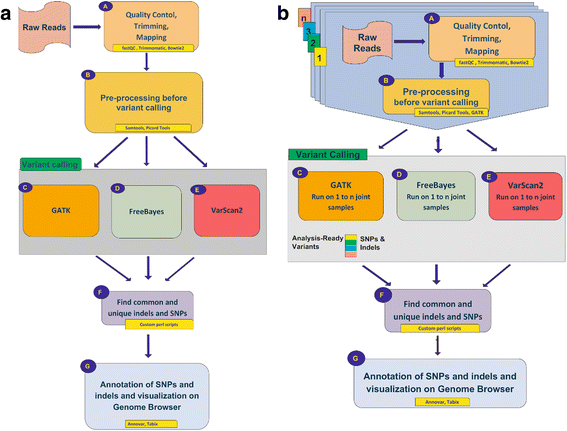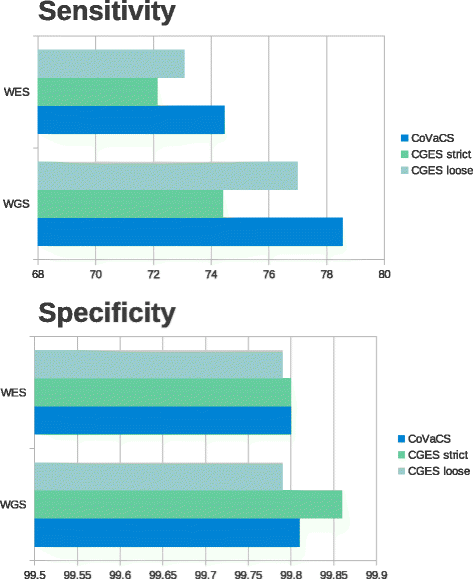CoVaCS: a consensus variant calling system
- PMID: 29402227
- PMCID: PMC5800023
- DOI: 10.1186/s12864-018-4508-1
CoVaCS: a consensus variant calling system
Abstract
Background: The advent and ongoing development of next generation sequencing technologies (NGS) has led to a rapid increase in the rate of human genome re-sequencing data, paving the way for personalized genomics and precision medicine. The body of genome resequencing data is progressively increasing underlining the need for accurate and time-effective bioinformatics systems for genotyping - a crucial prerequisite for identification of candidate causal mutations in diagnostic screens.
Results: Here we present CoVaCS, a fully automated, highly accurate system with a web based graphical interface for genotyping and variant annotation. Extensive tests on a gold standard benchmark data-set -the NA12878 Illumina platinum genome- confirm that call-sets based on our consensus strategy are completely in line with those attained by similar command line based approaches, and far more accurate than call-sets from any individual tool. Importantly our system exhibits better sensitivity and higher specificity than equivalent commercial software.
Conclusions: CoVaCS offers optimized pipelines integrating state of the art tools for variant calling and annotation for whole genome sequencing (WGS), whole-exome sequencing (WES) and target-gene sequencing (TGS) data. The system is currently hosted at Cineca, and offers the speed of a HPC computing facility, a crucial consideration when large numbers of samples must be analysed. Importantly, all the analyses are performed automatically allowing high reproducibility of the results. As such, we believe that CoVaCS can be a valuable tool for the analysis of human genome resequencing studies. CoVaCS is available at: https://bioinformatics.cineca.it/covacs .
Keywords: Consensus method; Graphical user interface; Variant annotation; Variant calling; Variant prioritization; Web server; Workflow.
Conflict of interest statement
Ethics approval and consent to participate
The authors testify that this work was performed in accordance with the Declaration of Helsinki and have been approved by the Ethical, Legal and Social Implications (ELSI) Committee of the Istituto di Biomembrane Bioenergetica e Biotecnologie Molecolari, Consiglio Nazionale delle Ricerche, Bari, Italy (Ref. 2017/06/29).
Consent for publication
Not applicable
Competing interests
The authors declare that they have no competing interests.
Publisher’s Note
Springer Nature remains neutral with regard to jurisdictional claims in published maps and institutional affiliations.
Figures




Similar articles
-
Variant Calling From Next Generation Sequence Data.Methods Mol Biol. 2016;1418:209-24. doi: 10.1007/978-1-4939-3578-9_11. Methods Mol Biol. 2016. PMID: 27008017
-
JWES: a new pipeline for whole genome/exome sequence data processing, management, and gene-variant discovery, annotation, prediction, and genotyping.FEBS Open Bio. 2021 Sep;11(9):2441-2452. doi: 10.1002/2211-5463.13261. Epub 2021 Aug 11. FEBS Open Bio. 2021. PMID: 34370400 Free PMC article.
-
ReliableGenome: annotation of genomic regions with high/low variant calling concordance.Bioinformatics. 2017 Jan 15;33(2):155-160. doi: 10.1093/bioinformatics/btw587. Epub 2016 Sep 7. Bioinformatics. 2017. PMID: 27605105 Free PMC article.
-
Review of alignment and SNP calling algorithms for next-generation sequencing data.J Appl Genet. 2016 Feb;57(1):71-9. doi: 10.1007/s13353-015-0292-7. Epub 2015 Jun 9. J Appl Genet. 2016. PMID: 26055432 Review.
-
The Genome Sequencer FLX System--longer reads, more applications, straight forward bioinformatics and more complete data sets.J Biotechnol. 2008 Aug 31;136(1-2):3-10. doi: 10.1016/j.jbiotec.2008.03.021. Epub 2008 Jun 21. J Biotechnol. 2008. PMID: 18616967 Review.
Cited by
-
De novo transcriptome assembly and annotation for gene discovery in Salamandra salamandra at the larval stage.Sci Data. 2023 May 27;10(1):330. doi: 10.1038/s41597-023-02217-9. Sci Data. 2023. PMID: 37244908 Free PMC article.
-
An increased burden of rare exonic variants in NRXN1 microdeletion carriers is likely to enhance the penetrance for autism spectrum disorder.J Cell Mol Med. 2021 Mar;25(5):2459-2470. doi: 10.1111/jcmm.16161. Epub 2021 Jan 21. J Cell Mol Med. 2021. PMID: 33476483 Free PMC article.
-
Accuracy and reproducibility of somatic point mutation calling in clinical-type targeted sequencing data.BMC Med Genomics. 2020 Oct 15;13(1):156. doi: 10.1186/s12920-020-00803-z. BMC Med Genomics. 2020. PMID: 33059707 Free PMC article.
-
SeqVItA: Sequence Variant Identification and Annotation Platform for Next Generation Sequencing Data.Front Genet. 2018 Nov 14;9:537. doi: 10.3389/fgene.2018.00537. eCollection 2018. Front Genet. 2018. PMID: 30487811 Free PMC article.
-
ELIXIR-IT HPC@CINECA: high performance computing resources for the bioinformatics community.BMC Bioinformatics. 2020 Aug 21;21(Suppl 10):352. doi: 10.1186/s12859-020-03565-8. BMC Bioinformatics. 2020. PMID: 32838759 Free PMC article.
References
Publication types
MeSH terms
Grants and funding
- EPIGEN/Ministero dell'Istruzione, dell'Università e della Ricerca/International
- MTJU9H8: DICLIMAX: Strumentazione per diagnostica clinica basata su Next Generation sequencing di acidi nucleici,/Regione Puglia/International
- Bando di ricerca finalizzata e giovani ricercatori GR-2011-02347129/Ministero della Salute/International
LinkOut - more resources
Full Text Sources
Other Literature Sources
Research Materials
Miscellaneous

